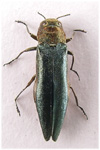Confined to southern and mostly South Eastern England. Plant feeders, in woody or herbaceous stems. Found through the summer and active in bright sunshine. The smaller species, Trachys and Aphanistictus, cause leaf mines and overwinter as adults.
Buprestinae includes 3 genera and 5 species. Buprestis aurulenta (L.)13.5-19.5mm) is our only regularly imported species, it occurs in softwoods imported from north America, adults may emerge from wood up to fifty years after processing (Levey). Shaw (1961) gives a list of records but the species is probably much more common than records would suggest (Hickin). Anthaxia nitidula (L.) is very local, recorded from south Hampshire but not in recent years (Levey). Two more species of Anthaxia appear on the british list; A.salicis (F.) is unlikely ever to have been native, and A.quadripunctata (L.) �. Melanophila acuminata (De G.) is associated with burnt wood, generally conifers, to which the adults may fly great distances to lay eggs. Very local and rare, the only recent records seem to be from north Hampshire (Alexander).
� Included on the british list on the strength of one old and two modern records. The species develops in conifers. West Sussex. See Cooter, J. 1992 Ent.Gaz. 43:75 for a description.
Agrilinae includes 3 genera and 12 spp. Of our six Agrilus species four are widely distributed in the southeast: A.angustulus (Ill.) and A.biguttatus (F.) (Allen, 1988) A.laticornis (Ill.) and A.sinuatus (Olivier). A.viridis (L.) and A.sulcicollis Lacordaire (James, 1994) are very local. Neither of our Aphanisticus species are common. A.emarginatus (Olivier) is associated with rushes (Levey quotes Juncus articulatus L. as larval host), this species was last recorded in 1951 (Alexander). A.pusillus (Olivier) has occurred throughout the south of England. Three species of Trachys (1.75-3.75mm) occur in Britain. T.minutus (L.) is a very local english species with few modern records (Alexander). Adults can be swept or beaten from salix spp. or Carpinus betulus L. T.scrobiculatus Kies. is a widespread southern english species found on Gtechoma hederacea L. (Ground Ivy) and Hyoscyamus niger L. (Henbane), adults occur year round. T.troglodytes Gyll. is our most widespread species across southern England with records mostly west of Hampshire, also from Wales and Anglesea. Adults from Succisa pratensis Moench (devil's Bit Scabious) in the summer and among Sphagnum during the winter.
Levey's handbook covers all british species, including Buprestis aurulenta, except Anthaxia quadripunctata and Agrilus sulcicollis, these are both dealt with by Bily who does not, however, include Agrilus sinuatus (Olivier) or Buprestis aurulenta. Both works, but more especially Bily, include much interesting ecological data and (fairly) straightforward keys. Distribution maps for most of our species are given by Alexander.
Hickin provides a key but this does not include Anthaxia quadripunctata or Agricollis sulcicollis. Several occasionally introduced species are discussed.
The family is dealt with by Lompe, A 1979 in Freude,H. Die Kafer Mitteleuropas Vol.6.
References
Allen, A.A. 1988. Notes on Agrilus pannonicus Pill. et Mitt. 1985. Ent.Rec.J.Var. 100:225-228.
James, T.J. 1994 Agrilus sulcicollis: A jewel beetle new to Britain. Coleopterist 3:33-35
Shaw, M.W. 1961. Ent.Mon.Mag. 97:97-98
Agrilus angustulus

Agrilus sulcicollis
Agrilus sulcicollis

Agrilus viridis
Home